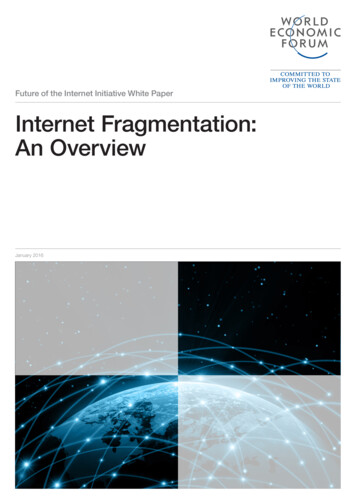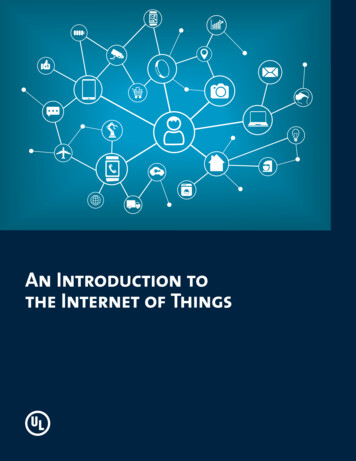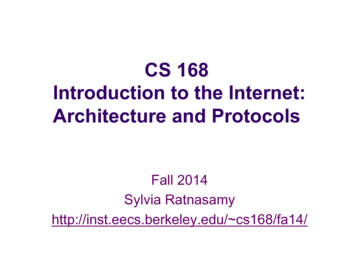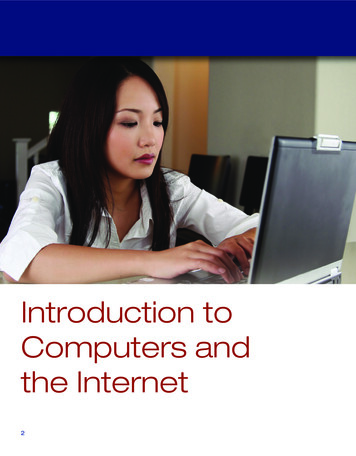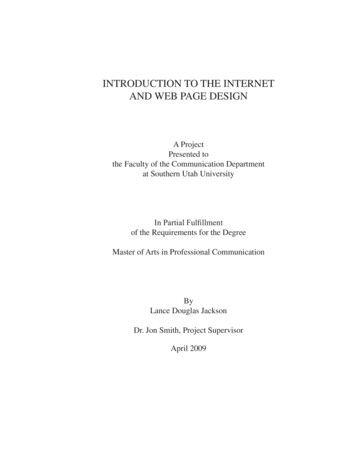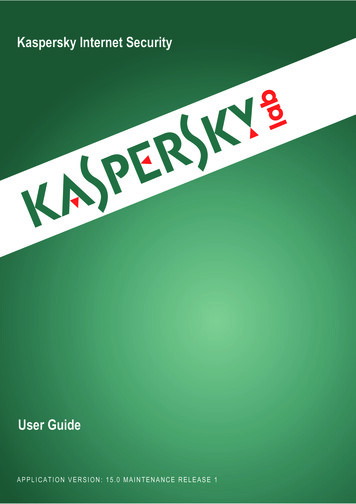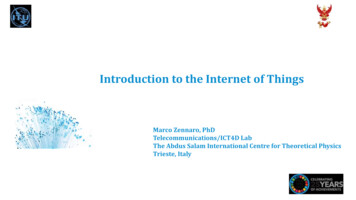
Transcription
Introduction to the Internet of ThingsMarco Zennaro, PhDTelecommunications/ICT4D LabThe Abdus Salam International Centre for Theoretical PhysicsTrieste, Italy
VisionIntroduction to IoT
History of IoT The first telemetry system was rolled out in Chicago way back in1912. It is said to have used telephone lines to monitor data frompower plants. Telemetry expanded to weather monitoring in the 1930s, when adevice known as a radiosonde became widely used to monitorweather conditions from balloons. In 1957 the Soviet Union launched Sputnik, and with it the SpaceRace. This has been the entry of aerospace telemetry that createdthe basis of our global satellite communications today.Introduction to IoT
History of IoT Broad adoption of M2M technology began in the 1980s with wiredconnections for SCADA (supervisory control and data acquisition) onthe factory floor and in home and business security systems. In the 1990s, M2M began moving toward wireless technologies.ADEMCO built their own private radio network to address intrusionand smoke detection because budding cellular connectivity was tooexpensive. In 1995, Siemens introduced the first cellular module built for M2M.Introduction to IoT
History of IoTIntroduction to IoT
Why IoT now? Introduction to IoTUbiquitous ConnectivityWidespread Adoption of IPComputing EconomicsMiniaturizationAdvances in Data AnalyticsRise of Cloud Computing
RPi Zero: 5Introduction to IoT
IoT DefinitionIntroduction to IoT
ITU Definition Recommendation ITU-T Y.2060 provides an overview of theInternet of Things (IoT). It clarifies the concept and scope of theIoT, identifies the fundamental characteristics and high-levelrequirements of the IoT and describes the IoT reference model. Date: 2012-06-15Introduction to IoT
ITU Definition“The IoT can be viewed as a globalinfrastructure for the information society,enablingadvancedservicesbyinterconnecting (physical and virtual)things based on existing and evolvinginteroperableinformationandcommunication technologies (ICT).”Introduction to IoTSource: Recommendation ITU-T Y.2060
ThingsThings are objects of the physical world (physicalthings) or of the information world (virtual world)which are capable of being identified andintegrated into communication networks. Thingshave associated information, which can be staticand dynamic.Introduction to IoTSource: Recommendation ITU-T Y.2060
ThingsPhysical things exist in the physical world andare capable of being sensed, actuated andconnected. Examples of physical things includethe surrounding environment, industrial robots,goods and electrical equipment.Virtual things exist in the information world andare capable of being stored, processed andaccessed. Examples of virtual things includemultimedia content and application software.Introduction to IoTSource: Recommendation ITU-T Y.2060
Introduction to IoTSource: Recommendation ITU-T Y.2060
Any-Time/Place/ThingIntroduction to IoTSource: Recommendation ITU-T Y.2060
Introduction to IoT
ITU DefinitionA device is a piece of equipment with themandatory capabilities of communication andoptional capabilities of sensing, actuation, datacapture, data storage and data processing. Thedevices collect various kinds of information andprovide it to the information and communicationnetworks for further processing.Some devices also execute operations based oninformation received from the information andcommunication networks.Introduction to IoTSource: Recommendation ITU-T Y.2060
Fundamental characteristics Interconnectivity: With regard to the IoT, anything can beinterconnected with the global information and communicationinfrastructure. Heterogeneity: The devices in the IoT are heterogeneous asbased on different hardware platforms and networks. They caninteract with other devices or service platforms throughdifferent networks. Dynamic changes: The state of devices change dynamically,e.g., sleeping and waking up, connected and/or disconnectedas well as the context of devices including location and speed.Moreover, the number of devices can change dynamically.Introduction to IoTSource: Recommendation ITU-T Y.2060
Fundamental characteristics Enormous scale: The number of devices thatneed to be managed and that communicate witheach other will be at least an order of magnitudelarger than the devices connected to the currentInternet. The ratio of communication triggered bydevices as compared to communication triggeredby humans will noticeably shift towards devicetriggered communication.Introduction to IoTSource: Recommendation ITU-T Y.2060
PredictionsIntroduction to IoTSource: Cisco IBSG, April 2011
PredictionsIntroduction to IoT
PredictionsIntroduction to IoTSource: rnet-of-things-infographic/
Internet of Fewer ThingsIntroduction to nternet-of-fewer-things
Introduction to IoT
IoT ArchitectureNodeGatewayServices
IoT Architecture: nodeSensorProtocolWireless link ProtocolController, Memory, Power Management
IoT Architecture: gatewayInput same standard as Output?
IoT Architecture: gateway access pointWiFiEthernet
IoT Architecture: gateway!BTEthernet
IoT Architecture: gateway!SMSEthernet
IoT Architecture: servicesGraphingMachine LearningAlerting
IoT Architecture: nodeSensorProtocolWireless linkController, Memory, Power Management
Network ConnectivityKey aspects when considering network connectivity: Range - are you deploying to a single office flooror an entire city? Data Rate - how much bandwidth do you require?How often does your data change? Power - is your sensor running on mains orbattery? Frequency - have you considered channelblocking and signal interference? Security - will your sensors be supporting missioncritical applications?Introduction to IoT
Introduction to IoTSource: rnet-of-things-infographic/
IPv6Smart Objects will add tens of billions of additionaldevicesThere is no scope for IPv4 to support SmartObject NetworksIPv6 is the only viable way forwardSolution to address exhaustionStateless Auto-configuration thanks toNeighbor Discovery ProtocolEach embedded node can be individuallyaddressed/accessedIntroduction to IoT
Connectivity LandscapeIntroduction to IoT
IoT Architecture: nodeSensorProtocolWireless linkController, Memory, Power Management
Introduction to IoTSource: rnet-of-things-infographic/
Introduction to IoT
ApplicationsIntroduction to IoT
ApplicationsIntroduction to IoT
Introduction to IoT
Introduction to IoT
Introduction to IoT
Introduction to IoT
Introduction to IoT
IoT LandscapeIntroduction to IoT
Thank You
Introduction to IoT ITU Definition “TheIoT can be viewed as a global infrastructure for the information society, enabling advanced services by interconnecting (physical and virtual) things based on existing and evolving interoperable information and communication technologies (ICT).” Source: Recommendation ITU-T Y.2060
